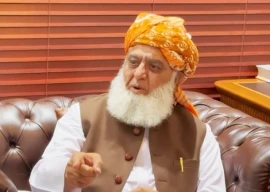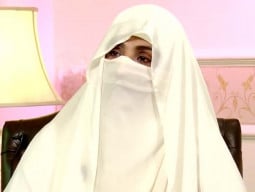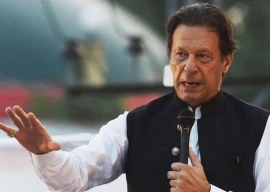
Pashto cinema is undergoing an identity crisis; it is now synonymous with buxom women with gyrating hips. Its audience is critical of these vulgar dance sequences and the days where these very films were commended for mirroring social issues are long forgotten.
Oddly enough, the racy dance numbers and provocative moves in contemporary Pashto films that have evoked criticism are blamed on “the Punjabi influence”. “The women doing mujras in Pashto films hail from Punjab. They wouldn’t be alive if they were living in Khyber-Pakhtunkhwa,” Farhad Ahmed, a shop owner in the Nishtarabad CD market of Peshawar, tells The Express Tribune.
Ahmed, who is also the president of the Nishtarabad CD union, says that to avoid threats from conservative groups, shop owners at the CD centre don’t stock controversial films any longer. Ironically, these films still manage to get airtime on cable television.
“We have requested the authorities to form a local censor board in Peshawar that monitors the release of such films in the market,” Ahmed says. “But despite our meeting with senior ministers, nothing really worked out,” he adds. “The names that run in the credits of the films are usually made up, which is why no one can really trace the producers.”
A clash of ideologies
Like many other shop owners in the region, Ahmed believes that unlike the Pashto filmmakers of yesteryear, Punjabi producers’ inclination towards risqué entertainment overshadows the social issues portrayed in films. CD shop owners feel victimised because they are physically and financially punished whenever controversial films flood the markets of Peshawar. “Most people in the K-P region watch and enjoy the vulgarity,” says a CD shop owner, who chose to remain anonymous. “But just to stay true to the “extremism” label, they will target people like us without realising that we haven’t released these films in the market!” he added.
“Trust me, no one wants to stop the production of these films more than us,” says another shop owner from the market.
Well-known Pashtun writer and an expert on Pashtun culture, Saadullah Jan Barq says that blaming Punjab for everything is “people’s way of running away from the truth”. Sitting in his hujra (guest room) in Nowshera, Barq elaborates on this sensitive matter. “People with this commercial mentality are present everywhere, so we can’t really blame one ethnic group for bringing vulgarity into Pashto cinema,” Barq told The Express Tribune.
Barq feels that there is no question of the Pashto film industry’s standards deteriorating, as he feels that it never truly entered into its “golden days”.
“Its golden age lasted for only about three years in the mid 70s,” said Barq, adding that films like Beedan were released but then influential people from Lahore and Peshawar changed the pattern altogether. “It took some time for gujjars (Punjabi heroes) to enter the Pashto film industry, but smugglers and dacoits were already there,” says Barq. “After this, Punjab started influencing the film industry in many ways. Frankly speaking, they have the technology to make and release films and we don’t,” he said, adding that the Punjabi influence in Pashto films was inevitable.
According to Barq, unlike Lollywood, the state of the Pashto film industry was never affected by changes in the political scenario. It was, however, affected by the influx of Afghan immigrants after the Soviet invasion. “Immigrants came in a state of despair, and watching these obscene films became the best escape for them. This provided the producers an incentive to make scandalous films,” says Barq.
The average man in Peshawar, however, chooses to distance himself from the issue of vulgarity in films, and considers it “a conspiracy against the Pashtuns”. The prevalent belief in the region is that respect for women is an integral part of Pashtun culture and a Pathan would never produce work like this.
At the end, Barq makes a balanced observation. “Punjabis are a respectable ethnic group and have immense respect for their women. The Punjab producers portray in their films doesn’t represent their values or norms,” he says.
He adds that in a few years, using vulgarity to draw in crowds won’t work for both Punjabi and Pashto producers, as the audience is getting fed-up. “I am actually optimistic about the future of Pashto cinema,” says Barq. “So much bad work has happened that it can only get better from here.”
Published in The Express Tribune, June 30th, 2012.
COMMENTS (24)
Comments are moderated and generally will be posted if they are on-topic and not abusive.
For more information, please see our Comments FAQ
1724760612-0/Untitled-design-(12)1724760612-0-405x300.webp)
















the article though tried to present a balance ... it was provocative
What a pathetic article from the ever manipulative ET . Its deplorable to see ET publishing such articles which carry with themselves a great recipe to starting ethnic lampooning. To top it up we have Indians posing as Pakistanis /Muslims fueling the already ET created drama. Its a shame for ET to publish such articles. Its better if the writers can focus themselves on something positive. Every Pashtun, Punjabi, Balochi, Sindhi etc. is honourable. Moreover We pashtuns, punjabis, Sindhis and Balochis (In essence, Pakistanis) derive our values from Quran and Sunnah and those of us who do not would in their sane mind not support such behaviors. Vulgarity be it in social media or anywhere else is the trait of people without morals who want the shortest path to getting rich. We find such people everywhere in the world. Every culture is respectable and every culture despises vulgarity, immorality.
@Jameel ur Rasheed: Mr Jameel Sometimes people confuse Dignity with a Superiority Complex and they are two different things and I think that is the case with Miss Sara Comment as well and I dont think she is in Superiority complex but she Raised her voice and that is what everyone with some Sort of Dignity should do and she did it . Also remember Language is a sensitive topic as it represents certain group of People and keep in mind that one Small Comment of Dr Zulfiqar in the past led to the bloodshed in Karachi last year when Urdu Speakers were Bashed by Him so same is the case here that the Writer not only imply movies of one region but it is directly alluring to One Ethnicity and everyone with Self Respect will do that.
@Sara that was the point lady, vulgarity has no language! And if the above mentioned article annoys you, then am sorry to say you are suffering from some sort of superiority complex of being Punjabi! Language has nothing to do with actions!! So better take it easy and just laugh at the article and the comments!
@kaalchakra: kaalchakra I am a Punjabi and I know my lineage and History very well. Do you know before 1947 Punjab, SIndh, Parts of Balochistan and parts of KPK which are now parts of Pakistan were infact Parts of India and since they were part of India so by Definition the people living here were Indians too?. Also keep in mind that there is no such thing as Pakistani culture. Also there is no such thing as One Indian Culture. Culture is just a way of life and Pakistan infact have more than 6 different cultures like India have more than 20 different cultures. Are you of the view that Punjabis and Sindhis came from the Sky that they were not Indians before 1947?. Also Muhajirs of Karachi were the same like Punjabi and Sindhis and they were Indians before 1947 too. So I think by blaming Indian Culture really means we are blaming our own Ancestors. Also there is a rich culture of Punjab which include celebrations in weddings to many dances ( and no they are not Vulgar ) and that must be preserved. Blame the mindset not the culture. In India there are more Muslims than in Pakistan. Also Culture is not a Property of Some Religion as one culture represents people of different religions like in Punjab we have Sufis, Sikhs and Muslims and Christians as well.
@ Rana
[my comments are "self explanatory", doesn't REQUIRED and eminent IQ] hats off to your 'eminent' command over the English Language unfortunately, you did not answer my previous question. Once again, in your pristine grammar: "Does it REQUIRED to be elaborated further, for what Pashtuns are particularly fond of??"
So what are Pashtuns particularly fond of? And please, no twisted answers this time, (since some of us don't have that 'eminent' IQ...
Dear friends, instead of blaming each other why don't we realize that all vulgarity comes from India?! Indian influence has corrupted both Punjabi and Pushtoon cultures. Both are helpless victims of Indian immorality and hegemony. Punjabis and Pushtoons should join hands to ban Indian culture and promote local Pakistani Islamic culture which improves people's morals, not harms them.
@Jameel ur Rasheed Its not ET; Its Pushtoons themselves saying it. In one line they say that vulgarity is bad and is coming from Punjab and in an other line they say that they enjoy watching that vulgarity.
So who is the hypocrite here. Blaming another ethnicity for your lewdness and fondness of vulgar movies is just wrong on so many levels and offends me as a Punjabi.
BTW I love pashto movies!
Congrats ET for evoking an unwanted Punjabi-pushtoon debate! That was all we wanted at this point. I did not know vulgarity has language as well!
I am sharing a link of the latest joint collaboration of Indian and Pakistani Punjabi Cinema. If anyone have time then please do watch it as people dont know what is a real Punjabi cinema as Punjabi cinema is diverse and it includes stories ranging from love to Sufism and it talk about our culture as well. Some dances are a Part of Punajbi culture but blaming them for vulgarity is a lame excuse of others in my view. Please take a look at these two latest movies. One is about Waris Shah ( A Famous Sufi Of Punjab) and the other movie is by Jawad Bashir Virsa for the Culture of Punjab. Also after watching these movies please tell me how these movies are influencing you in real Sense. http://www.youtube.com/watch?v=30KacbsLA http://www.youtube.com/watch?v=pbbKm3aicFE
@Asad:
Dear Asad, my comments are self explanatory, doesn’t required an eminent IQ, regards
"most people in the K_P region watch and enjoy vulgarity" Yep this sentence says it all. And as a women I know how much pushton respect women. Infact so much that many women in punjab feel uncomfortable to go into shops run by them. So they should really stop with this holier than thou attitude. Not being racist just telling the truth.
@ Rana:
could you please elaborate/explain your last question? and could you please make more sense this time around...
Thanks!
@Proud Punjabi: @Ordinary Villager:
Sane voices, appreciable!!
Does it required to be elaborated further, for what Pashtuns are particularly fond of??
I think that most Pashtuns know that there are seedy elements in Pashtun culture who are only too eager to make a quick buck. It may help to deflect criticism to blame it on another province or culture but as someone from Peshawar, we all know what goes on among Pashtuns in KPK and it has nothing to do with people from other provinces. Pashtun men love to oogle other women but keep their own women under lock and key. Therein lies the hypocrisy.
useless article. So do million of Punjabis force the angelic Pashtuns to make vulgar movies by keeping a gun on their throat?
Express Tribune is filled with articles that express hatred towards Punjab and Punjabis. I wonder if Express Tribune will publish something that expresses racism towards Pashtuns, Sindhis, Balochis or Urdu-speaking ethnic group.
HOLY! Blaming this on Punjabis? I don't mean to disrespect my Pashtun brothers, but honestly, I hear all the time that the Punjabis are to be blamed for the extremism in Pakistan. Some Pashtuns claim that the Taliban are Punjabis. And honestly, one went to the extreme saying that Somalia was in the mess that it was because of "PUNJABI" ISI. Here in Lahore, we have Baloch students, Sindhi students and we have an ever increasing population of Pashtuns but NEVER has any Punjabi killed or hurt a non Punjabi. All this when we get massacred the moment we step out of Punjab. PLEASE think before you blame it on us. We are being split into many groups by different parties playing their politics with us. Our language is being wiped out. Our land broken. And we get blamed for everything. No wonder some Punjabis have started hating Pakistan
Here I was feeling guilty because I thought only Bollywood and Hollywood are the reason for vulgarity in Pakistani society...
Hypocrisy at it's best. Our national character is to make profit from any source, i.e., vulgarity, prostitution, homosexuality, porn using the cinema, DVDs, the internet or the publishing media. Pashtun allegation of Punjabi involvement are self-serving. They used the infrastructure and the economies of scale of Punjabi Film establishment to make vulgar films. They could have equally made positive character forming films genre. But they didn't, so why blame someone else. Now who murdered Ghazala Javed and her father in Cold Blood??? She was not a vulgar dancer but a beautiful young women with a voice of a nightingale. Why was she cut down in her prime?? Was murder too a Punjabi event??
I don't think this issue of 'vulgarity' in Pashto films is a new phenomenon...Films in days of Badar Munir and Mussarrat Shaheen had content bordering on the risqué as well. Besides, how can ethnic group A can be blamed for influencing tastes of ethnic group B when the cinema of former isn't watched/popular amongst later. Or so I presume..
You had me at "Pashto cinema is now synonymous with buxom women with gyrating hips." The accuracy of this sentence is just commendable; so concise yet so true and well put. I cannot stop laughing! Well done, Rafay Mahmood. A good piece.